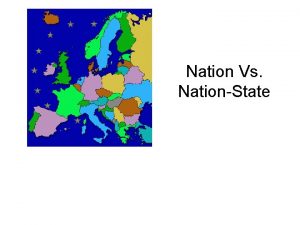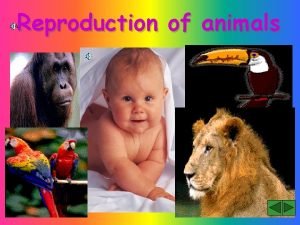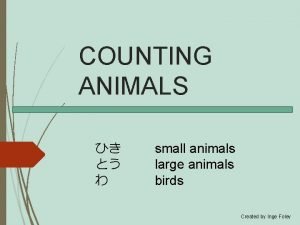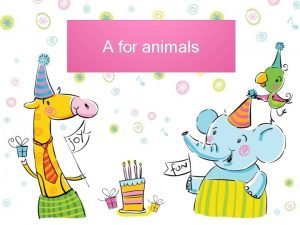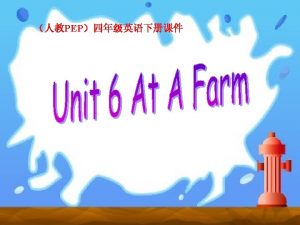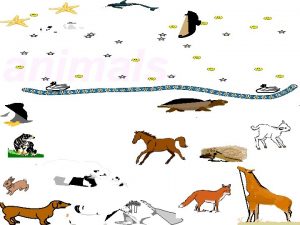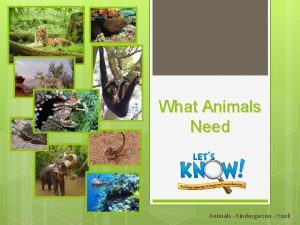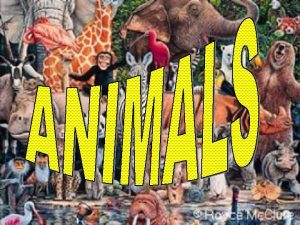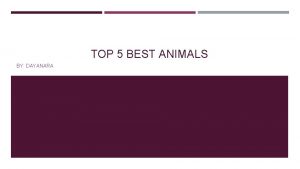CHINA National Animals The nation animals of China



















- Slides: 19

CHINA

National Animals • The nation animals of China include the Chinese Dragon, the Crane and the Giant Panda.

What Do The Colors Mean? One side states that the red color in China's flag symbolizes the revolution and the fact that the political power of China was achieved through the bloodshed of revolutionary martyrs who fought heroic struggles for the revolution. The big star is said to represent the Communist Party of China; while the four smaller stars are said to represent all of the ethnic groups that make up China. Much can be read into the fact that one point of the flag's big star points up the flag; while each of the smaller stars has a point aiming towards the centre of the big star. This is believed to signify that the Communist Party is the force at the core of the leadership of all Chinese people. The stars are yellow as an indication that the cause of socialism has a bright future in China

No National Flower China does not have an "official" national flower, but the tree peony can be known as a national favorite. The tree peony (mudan) received the most votes in a survey conducted in 1994 in every district in China asking people to select a National Flower – a high honor for the peony in a country that loves flowers.

10 Must See Sites 1. ) Grand Canyon Brahmaputra 2. ) Qinghai Lake 3. ) Ancient Trade Road of Tea and Horse 4. ) Erhai 5. ) Potala Palace 6. ) Tenggeli Desert - Tonghu Grassland Tourist District 7. ) Daqinggou National Natural Reserve 8. ) Scenic Lugu Lake 9. ) Shangri-La 10. ) Three Parallel Rivers of Yunnan Protected Areas

Grand Canyon Brahmaputra • Brahmaputra Grand Canyon is located in "roof of the world" on the Qinghai. Tibet Plateau, with an average altitude of 3000 meters above deep steep, erosion Cheddar under 5382 meters, with snow and ice from the mountains to the low valley of tropical monsoon rainforest nine vertical natural zone, is the world's mountain vertical naturally with the most complete, most comprehensive place. Brahmaputra Grand Canyon of the basic characteristics can be summed up in ten words: high, strong, dark, run, quiet, long, dangerous, low, odd show

Qinghai Lake • • Qinghai means green lake in Chinese and this is the largest inland saltwater lake in China. Lying in the northeast of Qinghai Province, approximately 150 km (193 miles) from Xining at 3, 200 meters (10, 500 ft) above sea level, the lake stretches endlessly into the horizon. It has an area of 4, 635 sq km and is more than 360 km (220 miles) in circumference. The lake has an abundant supply of fish, which in turn attracts large flocks of birds including many migratory breeds. Major sights on or around the lake are: Bird Island, Haixin Hill, Haixi Hill, Sankuaishi (Three Stones), and Sand Island.

Ancient Trade Road of Tea and Horse • The Ancient Tea Horse Road played a crucial role in the history of solidarity and exchanges between the Han and Tibetan ethnic groups in China. It was the most prominent route among all the trade paths between Sichuan and Tibet. Scholars from the Chinese Academy of Social Sciences have described this ancient trade route in the following, “The Ancient Tea Horse Road has concentrated the best natural and human sights of China. ”

• Erhai Lake is the largest highland lake next to Dianchi and one of the seven biggest fresh water lakes in China. It means, 'sea shaped like an ear', in Chinese. Implying that the lake is ear shaped and as large as a sea, hence it was so named. The lake covers an area of 250 square kilometers and is located about two kilometers east of Dali.

Potala Palace • Perched upon Marpo Ri hill, 130 meters above the Lhasa valley, the Potala Palace rises a further 170 meters and is the greatest monumental structure in all of Tibet. Early legends concerning the rocky hill tell of a sacred cave, considered to be the dwelling place of the Bodhisattva Chenresi (Avilokiteshvara), that was used as a meditation retreat by Emperor Songtsen Gampo in the seventh century AD. In 637 Songtsen Gampo built a palace on the hill. This structure stood until the seventeenth century, when it was incorporated into the foundations of the greater buildings still standing today.

Tenggeli Desert - Tonghu Grassland Tourist District • The district is located at 18 kilometers northwest of the county site of Zhongwei County, Alxa League of Inner Mongolia. Tonghu Grassland Tourist District is surrounded by sand dunes with grass, fresh air and numerous migratory birds. With white Mongolian tents dotted around the area, the district is full of Mongolian customs and is as beautiful as a painting.

Daqinggou National Natural Reserve • • • The reserve is situated in the territory of Horqin Left Wing Rear Banner, and Shenyang is 190 kilometers to the southeast, Horqin City is 100 kilometers to the north and Ganqika Town, the place where the governmentof the banner is located, is 25 kilometers to the east There is boundless water outside of the gorge and many mountains, beautiful woods and tall trees there. The uniqueness of Daqinggou lies in its diversity. The geomorphological sights include forests, grasslands, deserts, lakes and rivers. There are over 700 plants in Daqinggou. In the spring, the flowers are beautiful; in summer, green shade covers the whole area; in autumn, the maple leaves are like fire and in winter, it is misty. Stepping into Daqinggou in summer will rid you of the summer heat. In the freezing winter, Daqinggou is as warm as it is in thespring.

Scenic Lugu Lake • Lake Lugu is located between Sichuan and Yunnan Provinces , designating China key scenic and historical relics , which is world famous both for its beautiful national scenery and for its unique national customs. • Lake Lugu is one of the clearest plateau lakes of our country with a total area of 52 square kilometers , 2, 685 meters above sea level. The average depath of the lake is 45 meters and the deepest point is 93 meters , And the visibility is 12 meters. There are five islands , four peninsulas , One long island 14 anchors in the lake , The lake is surrounded by mountains , among them Mt. Goddess Gemu standing above others , The winding Houlong Mountain stretches into the center of the lake. All of these make lugu U-shaped

Shangri-La • Shangri La is the Honolulu home of Doris Duke. Built in 1937, Shangri La houses an impressive collection of Islamic art and is considered one of Hawaii’s most architecturally significant homes. Shangri La is open to the public for tours and special programs, and can also be visited by virtual tour.

Three Parallel Rivers of Yunnan Protected Areas • In the 1980 s, an expert at the United Nations found a marvelous natural scene on a satellite map of the Northern Hemisphere. In the northwest area of Yunnan Province, there are three rivers flowing parallel from the Qinghai. Tibet Plateau to the south, but never converge. This is the 29 th project of the World's Cultural and Natural Heritage in China, Three Parallel Rivers in Yunnan Protected Areas.

• Originating in the Tanggula Mountain on the Qinghai-Tibet Plateau, the Jinsha River, Lancang River and Nu River flow parallel along the Hengduan Mountains for several hundred kilometers. It is a very rare phenomenon that the shortest distance between the Lancang River and Jinsha River is only 66 kilometers (about 41 miles) and between the Lancang River and Nu River the distance is less than 19 kilometers (about 12 miles). Interestingly, their entrances to different seas are thousands of kilometers away.

Fun Facts • • • Giant pandas are a national treasure in China. There about 1, 600 pandas living in the wild today. The compass, paper, gunpowder, and printing are called the Four Greatest Ancient Chinese Inventions. Other Chinese inventions include fireworks and ice cream. In China, a person’s family name comes first, followed by the first name. There is no middle name. The three most popular Chinese family names are Li, Zhang, and Wang. In ancient China, Chinese characters were written on animal bones, turtle shells, silk, or bamboo slices.

More Fun Facts • • Fourth graders are expected to know 2, 000 of the over 40, 000 written Chinese characters. By the time they leave college, they will know 4, 000 or 5, 000 characters. Each character is learned by looking at it and memorizing it. Unlike the 26 letters of our alphabet, words cannot be sounded out letter by letter. When a Chinese child loses a baby tooth, it doesn't get tucked under the pillow for the tooth fairy. If the child loses an upper tooth, the child's parents plant the tooth in the ground, so the new tooth will grow in straight and healthy. Parents toss a lost bottom tooth up to the rooftops, so that the new tooth will grow upwards , too. Red is considered a lucky color in China. At one time wedding dresses were red. New Year's banners, clothing, and lucky money envelopes are still red.

 Country vs nation
Country vs nation Nation state vs nation
Nation state vs nation Nation vs nation state
Nation vs nation state Https//a-z-animals.com
Https//a-z-animals.com Producers consumers and decomposers
Producers consumers and decomposers Animals that eat both plants and animals
Animals that eat both plants and animals Carnivore
Carnivore Hát kết hợp bộ gõ cơ thể
Hát kết hợp bộ gõ cơ thể Frameset trong html5
Frameset trong html5 Bổ thể
Bổ thể Tỉ lệ cơ thể trẻ em
Tỉ lệ cơ thể trẻ em Chó sói
Chó sói Tư thế worm breton
Tư thế worm breton Hát lên người ơi alleluia
Hát lên người ơi alleluia Môn thể thao bắt đầu bằng chữ đua
Môn thể thao bắt đầu bằng chữ đua Thế nào là hệ số cao nhất
Thế nào là hệ số cao nhất Các châu lục và đại dương trên thế giới
Các châu lục và đại dương trên thế giới Công của trọng lực
Công của trọng lực Trời xanh đây là của chúng ta thể thơ
Trời xanh đây là của chúng ta thể thơ Mật thư anh em như thể tay chân
Mật thư anh em như thể tay chân

